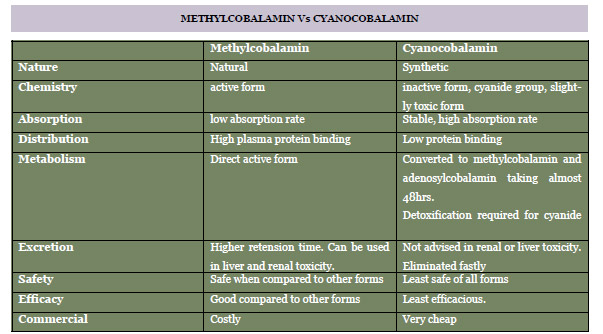INRODUCTION
Vitamin B12 (named as cobalamin) is considered to be the largest and one of the most complex vitamin of all the vita-min family. It is known to be unique, as it is the only vitamin that consists of a metal ion, named cobalt in its structure (hence its name). Cobalamin, popularly known as vitamin B12 is an important water-soluble vitamin which is involved in the synthesis of red blood cells , neu-ronal protection and DNA synthesis which are the vital functions of the body.
FORMS OF VITAMIN B12.
There are four forms of vitamin B12, mainly differentiated by the side group attached to the cobalamin molecule:
- Adenosylcobalamin (AdoCbl)
- Cyanocobalamin (CNCbl)
- Hydroxocobalamin (HOCbl)
- Methylcobalamin (MeCbl)
Methylcobalamin and Adenosylcobala-min are two different co-enzymes and the body requires both of them for dif-ferent processes.
Cyanocobalamin is the most commonly found form in supplements and forti-fied foods. It is considered to be the most stable form of all the forms of B12 available because of the side group, cya-nide, which is believed to be having the strongest attraction to the cobalamin molecule. It is also considered to be sta-ble in extreme conditions like high tem-peratures compared to other forms.
Hydroxocobalamin is the form of B12 commonly found in foods. There are not many oral formulations available for people to take and it is normally injected in B12 shots. It is not recommended to be taken orally as the hydroxyl side group has the least attraction to the cobalamin molecule.
Adenosylcobalamin’s chemically known as 5′-deoxy-5′-adenosylcobalamin is also known as dibencozide, cobama-mide, and cobinamide.
The main aim of this article, is to state the pros and cons of the two forms of B12 that we are con-cerned with namely methylcobal-amin and cyanocobalamin which are available in the market and are the types that are generally found in supplements and suggest the superiority of methylcobala-min over cyanocobalamin which is used commonly.
CYANOCOBALAMIN
Cyanocobalamin a form of vitamin B12 is considered to be a cheap, synthetic, mild toxic and an inactive form of B12. It con-sists of a cyanide donor in its chemical structure and is the most commonly used commercial preparation of vitamin B12 used. It is considered as the most stable form, because of the cyanide molecule present in the structure has the great attraction to the cobalamin and protects it from extreme conditions like high tem-peratures. It is not absorbed well orally and requires methyl groups to detoxify it.
The molecule that is attached to the co-balamin is known as a donor. It‘s used more frequently in supplements, since it‘s considered to be more stable and cost-effective than all the other forms of vitamin B12 available. When cyanocobal-amin enters your body, it is converted to either methylcobalamin or adenosylco-balamin, these are the two active forms of vitamin B12 in humans. When cyano-cobalamin is absorbed, it converts to hydroxocobalamin (which means dis-carding of the cyanide in the process) and then to methylcobalamin and adeno-sylcobalamin. When taken through oral route, absorption of this form is enormously reduced in case of any gastric acid problems.
Besides cyanocobalmin takes more than 48 hours to eventually convert to usable and active component methylcobalamin, and even then also only a small amount is con-verted. During this conversion it requires the interaction of possibly depletion of glutathione and other agents.

METHYLCOBALAMIN
Unlike cyanocobalamin which is synthet-ic in nature , methylcobalamin is a natu-rally occurring form of vitamin B12 which can be obtained through supple-ments, as well as food sources like fish, meat, eggs and milk. Methylcobalamin, is the kingpin, one of the two active, nat-ural forms of B12. It helps in reducing homocysteine concentrations and gener-ates SAMe (S-adenosyl methionine), which is the the most important methyl donor in our body, and supplying methyl groups for critical chemical reactions to help maintain our health. Methylcobala-min shows its greatest utility with people suffering form acute or chronic degener-ative neurological symptoms, here it is considered as the only promising treat-ment available. It bypasses several po-tential issues in the absorption cycle and helps relieve or completely reverse symptoms.
Cyanocobalamin takes a lot of ef-fort to reduce it to the active form, hence cyanocobalamin absorp-tion varies greatly between individ-uals. Methylcobalamin is considered significantly better utilized compared to other forms and is around 2.5 times more more potent (about 1/3 less is ex-creted in the urine) than cyanocobala-min. Even though similar doses are ―absorbed‖, but once absorbed, Methylcobalamin due to its high plasma protein binding capacity is accumulated and retained in the body much better than cyanocobalamin therefore the re-tention time is more. In any form, methylcobalamin has higher bioavaila-bility than cyanocobalamin. It is so efficient that even orally it was found effective in pernicious anemia.

CONCLUSION
Majority that is 99% of people in the world are in need of extra vitamin B12, and methylcobalamin would be consid-ered as a better option compared to cyanocobalamin. It exhibits many neuro-protective effects, improving brain cogni-tion back to normal levels. Plus, methylcobalamin is donating an ex-tremely valuable methyl group that fur-ther enhances our health (and doesn‘t steal any, like cyanocobalamin does). This is especially important for perni-cious anemia patients or anyone suffer-ing from high homocysteine levels. This donation of methyl groups may be the reason why methylcobalamin is helpful to multiple conditions.
~Dr Sanjay Agrawal


